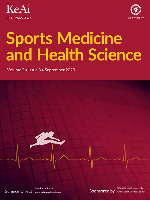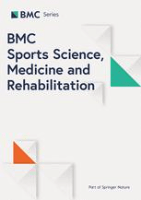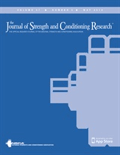
ISOKINETICS AND EXERCISE SCIENCE
Scope & Guideline
Catalyzing Discoveries in Biophysics and Sports Medicine
Introduction
Aims and Scopes
- Muscle Function and Performance Assessment:
The journal extensively covers research on muscle strength, endurance, and functional performance, utilizing various assessment techniques including isokinetic dynamometry, electromyography, and strength testing protocols. - Rehabilitation and Injury Prevention:
A significant focus is placed on rehabilitation strategies and injury prevention programs, aiming to enhance recovery outcomes and reduce injury incidence among athletes and general populations. - Exercise Physiology and Biomechanics:
Research exploring the physiological and biomechanical responses to different exercise modalities, including resistance training, flexibility exercises, and functional movements, is a core area of interest. - Training Interventions and Protocols:
The journal highlights studies investigating the efficacy of various training interventions, such as strength training, plyometrics, and balance exercises, to improve athletic performance and functional capabilities in diverse populations. - Innovative Techniques and Modalities:
Research on novel training techniques, including blood flow restriction, vibration training, and taping methods, is featured, emphasizing their implications for muscle performance and rehabilitation.
Trending and Emerging
- Integration of Technology in Exercise Science:
There is a growing trend towards utilizing technology, such as wearable devices and digital platforms, to assess and enhance exercise performance, indicating a shift towards data-driven training methodologies. - Focus on Functional and Sport-Specific Training:
Research emphasizing functional training and sport-specific exercises that cater to the unique demands of various sports is increasingly prevalent, reflecting a move towards personalized training regimens. - Mental Health and Exercise Interventions:
The intersection of mental health and physical exercise is gaining attention, with studies exploring how exercise can mitigate mental health issues, enhance psychological well-being, and improve quality of life. - Advanced Recovery Techniques:
Emerging themes in recovery strategies, including cryotherapy, hydrotherapy, and active recovery protocols, are increasingly being investigated, highlighting their role in optimizing performance and reducing injury recovery times. - Personalized and Adaptive Training Programs:
There is a noticeable increase in research focused on individualized training programs that adapt to the specific needs and capabilities of athletes, particularly in rehabilitation and performance enhancement contexts.
Declining or Waning
- Traditional Strength Training Modalities:
Research focusing solely on traditional strength training methods without the integration of innovative approaches or technology appears to be declining, as newer methodologies gain traction. - Basic Physiological Studies:
There seems to be a reduction in publications centered around fundamental physiological research without practical applications or interventions, as the field increasingly prioritizes applied research. - Static Stretching Research:
Studies solely investigating static stretching effects on performance and injury prevention are becoming less common, likely due to the rising interest in dynamic and functional movement strategies. - General Population Studies:
There is a noticeable decrease in research targeting general populations without specific conditions or athletic backgrounds, as the journal shifts focus towards more specialized or athletic populations. - Longitudinal Studies:
The frequency of longitudinal studies examining the long-term effects of training interventions on muscle function and performance seems to be diminishing, possibly due to the complexity and resource intensity of such research.
Similar Journals

Sports Medicine and Health Science
Championing Open Access in Sports Medicine ResearchSports Medicine and Health Science, published by KEAI PUBLISHING LTD, stands as a pivotal resource for scholars and practitioners in the dynamic fields of sports medicine and health sciences. Established as an open access journal in 2019, it provides a platform for rigorous research that fosters innovation and improvement in physical therapy, rehabilitation, and orthopedics. With an impressive range of quartile rankings, it is recognized as a Q1 journal in Physical Therapy, Sports Therapy and Rehabilitation, and Q1 in Rehabilitation as of 2023, highlighting its esteemed contribution to the academic community. The journal is also notable for its high Scopus rankings, including a rank of #19 in Medicine Rehabilitation, situating it within the top percentile of research in these areas. Based in Beijing, China, the journal's scope encompasses a wide array of topics, ensuring comprehensive coverage of advancements and emerging trends. With its commitment to open access and high-quality content, Sports Medicine and Health Science is an essential publication for researchers, healthcare professionals, and students seeking to enhance their knowledge and contribute to the field.

BMC Sports Science Medicine and Rehabilitation
Pioneering open-access research in sports science and rehabilitation.BMC Sports Science Medicine and Rehabilitation is a leading open-access journal published by BMC, based in the United Kingdom, dedicated to the dissemination of high-quality research in the fields of sports science, medicine, and rehabilitation. Established in 2013, the journal has quickly gained a prominent position, achieving Q2 rankings in major categories such as Orthopedics and Sports Medicine, Physical Therapy, Sports Therapy and Rehabilitation, and Rehabilitation as of 2023. With a Scopus ranking placing it in the 66th percentile for Rehabilitation and the 62nd percentile for Physical Therapy, BMC Sports Science Medicine and Rehabilitation serves as a vital resource for researchers, practitioners, and students alike. Its open-access format ensures that groundbreaking research is freely available, promoting knowledge exchange and fostering advancements in therapeutic practices and sports science innovations. Authors and readers are encouraged to engage with the journal's broad scope, spanning from evidence-based interventions to innovative rehabilitation strategies, all aimed at enhancing human performance and well-being.

Acta Kinesiologica
Enhancing well-being through rigorous scholarly discourse.Acta Kinesiologica is a distinguished journal dedicated to advancing the fields of kinesiology and health sciences. Published by the DRUSTVO PEDAGOGA TJELESNE & ZDRAVSTVENE KULTURE, this journal serves as a vital platform for researchers, professionals, and students to disseminate and engage with innovative findings in physical education, exercise science, and health promotion. With the ISSN 1840-2976 and E-ISSN 1840-3700, Acta Kinesiologica highlights contemporary research methodologies and interdisciplinary approaches that aim to enhance human movement and well-being. Although currently not an open-access journal, it is recognized for its commitment to quality and scholarly excellence. Researchers from around the globe benefit from its rigorous peer-review process, which ensures that only the most relevant and impactful studies are published. As the journal continues to evolve, it remains an essential resource for those seeking to expand their knowledge and contribute meaningfully to the scientific community in kinesiology and related disciplines.

BMJ Open Sport & Exercise Medicine
Innovating sports medicine through open access knowledge.BMJ Open Sport & Exercise Medicine is a leading open access journal published by the prestigious BMJ Publishing Group, dedicated to advancing the field of sports and exercise medicine. Launched in 2015, this journal has quickly made its mark, demonstrating exceptional quality as evidenced by its Q1 ranking in both Orthopedics and Sports Medicine and Physical Therapy, Sports Therapy and Rehabilitation as of 2023. With an impressive Scopus ranking, placing it in the top 8% of journals in these fields, it serves as an essential resource for researchers, practitioners, and students interested in the latest findings and innovations related to exercise and sports health. With the allure of open access, BMJ Open Sport & Exercise Medicine ensures that crucial research is readily available to a global audience, fostering collaboration and knowledge sharing across disciplines. This journal is not just a platform for publication; it is a catalyst for empirical studies and evidence-based practices that impact athletes and the rehabilitation of physical injuries.

Baltic Journal of Health and Physical Activity
Empowering knowledge for healthier communities.Baltic Journal of Health and Physical Activity is a distinguished, peer-reviewed academic journal published by Gdansk University of Physical Education and Sport in Poland. Since its inception in 2009 as an Open Access platform, the journal has provided a vital space for researchers and professionals to disseminate innovative findings in the fields of health, physical activity, and rehabilitation. With a current impact factor representative of its growing influence—ranking in the Q3 category across various related disciplines—this journal plays a crucial role in bridging research and practice. The journal's Scopus rankings indicate its relevance and visibility, particularly in health professions and education, making it an essential resource for academics, practitioners, and students invested in advancing health outcomes through physical activity. Covering a comprehensive editorial scope that converges insights from the years 2019 to 2024, the Baltic Journal of Health and Physical Activity continues to inspire rigorous research and discussion within its community.

Journal of Sports Science and Medicine
Innovating Rehabilitation Through ScienceJournal of Sports Science and Medicine is a premier open access journal published by JOURNAL SPORTS SCIENCE & MEDICINE, dedicated to advancing knowledge in the fields of sports science, medicine, and rehabilitation. With a rich history since its inception in 2002, this esteemed journal operates out of Turkey, specifically from the Department of Sports Medicine at Uludag University in Bursa. The journal has consistently achieved high recognition, proudly positioned in the Q1 category for both Orthopedics and Sports Medicine as well as Physical Therapy, Sports Therapy and Rehabilitation, while also securing a reputable Q2 ranking in Sports Science for 2023. Its Scopus ranking further emphasizes its impact, with the Physical Therapy, Sports Therapy and Rehabilitation category ranking #40 out of 247 journals, placing it in the 84th percentile. The Journal of Sports Science and Medicine serves as an essential platform for researchers, healthcare professionals, and students, facilitating the sharing of innovative findings and promoting multidisciplinary collaboration in a rapidly evolving field.

JOURNAL OF STRENGTH AND CONDITIONING RESEARCH
Elevating Standards in Sports Science and RehabilitationJournal of Strength and Conditioning Research, published by Lippincott Williams & Wilkins, stands at the forefront of the field of sports science, dedicated to advancing knowledge and application in strength and conditioning. With an impressive impact factor and consistently ranking in the Q1 quartile across categories such as Medicine, Orthopedics and Sports Medicine, and Physical Therapy, this journal is esteemed by researchers and practitioners alike. Covering a broad spectrum of topics within strength training and performance, it serves as a vital resource for evidence-based practice in athletic training and rehabilitation. Although it currently does not offer an Open Access model, the journal ensures the dissemination of high-quality research findings for scholarly discussion and application. Since its inception in 1987, the journal has maintained a commitment to fostering innovative research and facilitating collaboration among professionals. Its rigorous peer-review process assures that only the most impactful studies reach its readership, making it an invaluable asset for anyone involved in sports science and rehabilitation.

European Journal of Human Movement
Fostering Collaboration in Movement SciencesThe European Journal of Human Movement, published by the University of Extremadura, Faculty of Sports Sciences in Spain, stands as a vital resource within the realms of Health, Physical Therapy, and Social Sciences. With its consistent commitment to Open Access since 2014, the journal facilitates the dissemination of high-quality research, fostering innovation and collaboration among scholars, practitioners, and students alike. The journal has carved out a niche in its categories, being ranked in the Q3 quartile across several fields, including Health (social science) and Physical Therapy, Sports Therapy, and Rehabilitation. With an ongoing publication timeline extending from 2019 to 2024, it aims to highlight contemporary issues, emerging trends, and groundbreaking studies within human movement sciences. Additionally, with its presence in the Scopus ranking and a determination to elevate research standards, the journal remains an essential platform for sharing knowledge and advancing professional practice in a rapidly evolving landscape.

Journal of Functional Morphology and Kinesiology
Fostering Global Collaboration in Health SciencesJournal of Functional Morphology and Kinesiology is a premier platform dedicated to advancing the interdisciplinary study of anatomy, kinesiology, and rehabilitation sciences. Published by MDPI since 2016, this open-access journal aims to promote the latest research, innovative methodologies, and clinical applications in the field. With an impressive Q1 ranking in Anatomy and notable standings in related categories such as Orthopedics and Sports Medicine, this journal serves as a crucial resource for researchers, practitioners, and students alike. The journal is headquartered in Basel, Switzerland, and is committed to facilitating global collaboration and dissemination of knowledge. The 2023 Scopus rankings further underscore its impact, showcasing its position within the top percentile of related academic fields. As an essential contributor to the body of knowledge in functional morphology and kinesiology, this journal not only highlights cutting-edge research but also emphasizes practical applications that significantly impact health and rehabilitation.

Comparative Exercise Physiology
Connecting Research to Real-World Applications in ExerciseComparative Exercise Physiology is a peer-reviewed journal published by Wageningen Academic Publishers focused on advancing the scientific understanding of exercise physiology across various species and contexts. With its ISSN 1755-2540 and E-ISSN 1755-2559, it serves as a vital platform for disseminating research findings that bridge the gap between exercise science and comparative physiology, enriching the fields of biochemistry, biophysics, and sports medicine. The journal holds a notable position in the academic landscape, with a Q4 ranking in multiple categories and a commendable Q3 ranking in Orthopedics and Sports Medicine, highlighting its relevance and contribution to these domains. Although it operates without an Open Access model, the journal remains committed to providing well-researched and insightful articles that appeal to a diverse audience of researchers, professionals, and students aiming to enhance their knowledge and application of exercise physiology in both human and veterinary contexts. By fostering interdisciplinary dialogue and offering comprehensive insights, Comparative Exercise Physiology plays a crucial role in the pursuit of knowledge in the ever-evolving field of exercise science.